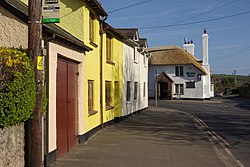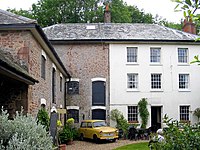Williton
| Williton | |
| Somerset | |
|---|---|

| |
| Location | |
| Grid reference: | ST077412 |
| Location: | 51°9’53"N, 3°18’31"W |
| Data | |
| Population: | 2,607 (2011) |
| Post town: | Taunton |
| Postcode: | TA4 |
| Dialling code: | 01984 |
| Local Government | |
| Council: | Somerset West and Taunton |
| Parliamentary constituency: |
Bridgwater & W. Somerset |
Williton is a large village in Somerset, at the junction of the A39, A358 and B3191 roads, on the coast two miles south of Watchet between Minehead, Bridgwater and Taunton. It belongs to and gives a name to the county's Williton and Freemanners Hundred.
Williton station is on the West Somerset Railway line. Doniford Halt on the same line serves the nearby Haven Holiday centre.
History
Until 1902 Williton was part of the ancient parish of Saint Decuman, which included also the town of Watchet.[1]
Within Williton parish, to the south-west, is Orchard Wyndham House, a Grade I listed building, [2] which was the centre of an estate called "Orchard".
Paleolithic, mesolithic and neolithic flints have been found at Doniford to the north-east of Williton while three Bronze Age barrows survive at Battlegore Burial Chamber, just north of the centre of Williton.
The name of Williton is Old English and means "estate on the Willet": the Willet is a brook that rises at Willet, flows north through the hamlet of Stream, and close to the former manor house of Williton, then it joins the Doniford Brook north-east of Williton. Both watercourses seem to have been known as the Willet in the 12th century. The river name "Willet" may well be a name from the old British language.
In the time of Edward the Elder the manor at Wiilitun was a royal hunting estate; its only pre-Conquest mention is in Edward's charter to the priory at Taunton, in which the prior and monks are enjoined to provide board and lodging for a single night, when the king was progressing, with dogs and falcons and their keepers, "ad Curig vel Willittun", "to Curry or else Williton".[3]
In the Domesday Survey Williton continued to form a royal estate, with Carhampton and Cannington. In the Middle Ages the village was divided into the manors of Williton Fulford and Williton Hadley. An estate known as Williton Templar belonged to the Knights Templar, and was later known as Williton Hospital and Williton Regis. Originally the centre of the village appears to have been near the church but over time it has migrated to the north-east.
Much of the centre of Williton dates from the later 19th century but Long Street includes several 17th-century houses, as do Bridge, Priest, Robert and Shutgate Streets. Agriculture has been the prime activity in the parish while Williton village became a local government and communal centre. Its importance increased with the creation of new toll roads that today are the main roads to the village. It is an important local shopping area and from 1894 has been an administration centre. It had a workhouse for the district, which became the local hospital until 1990 but has now been converted into housing.
Doniford House has late mediæval origins and was enlarged circa 1600.[4] Beside the beach is an early 19th-century lime kiln which is thought to have been in operation until the 1930s.[5]
Before the Second World War at a site between Watchet and Doniford a gunnery range was established for various army units to practice anti-aircraft gunnery. Unmanned target aircraft were towed by planes from RAF Weston Zoyland and later were fired from catapults over the sea.[6] Little of the camp buildings survive and it is now the site of a holiday park.[7]
Geology
Doniford Bay has Jurassic fossils in the cliffs. Charmouth fossils collects a number of their fossils from Doniford.[8]
The largest Ichthyosaurus fossil discovered was found in Doniford Bay and taken to a museum in Hanover. When it was examined in 2017 it was revealed as the largest specimen described.[9]

Tourism
Williton is a good centre for visiting the Quantock Hills, the Brendons and Exmoor as well as the coast at Minehead, Dunster, Blue Anchor and Watchet, which are on the West Somerset Coast Path. Accommodation may be obtained in the village. There are facilities nearby for camping, sailing and wind-surfing as well as the usual beach activities. On the nearby cliffs fossils are exposed. There is easy access to the West Somerset Railway, which is the longest private railway in the country, and is run by a trust.
Places of interest are the Bakelite Museum and the Tropiquaria Zoo at the old radio station. Halsway Folk Music Centre is not far away.
The village lies on the route of the Macmillan Way West and Celtic Way Exmoor Option.
Parish church

The date of the origin of St Peter's Church in Bridge Street is uncertain but it is believed that God has been worshiped on the site for more than 1,000 years.[10] The names of the priests serving the church and the parish can be traced back go the 13th century.
The status of the Church changed dramatically in 1170 when the Lord of the manor, Sir Reginald Fitzurse, became one of the murderers of St Thomas a Becket. Following the murder the ownership of the manor passed to Reginald's brother Robert and the Knights Templar.[11] The historian Collinson records (1792) that Robert rebuilt the chapel of Williton implying that the Saxon chapel was in ruins. The Liber Albus manuscripts in Wells Cathedral library show Robert gave to the Church of St Decuman, Watchet some important property and certain rights in the chapel.[11] The church at Williton thus became very much a daughter Church of Watchet and became known as a chapel of ease.
The current building is mostly from the 16th century and is now a Grade II* listed building.[12] Further work was undertaken in the 17th century when the Church was known as All Saints. Further work was done from time to time and in 1810 a south extension was built though the Elizabethan windows were relocated and reused in the south wall. The church fell into a state if disrepair and in 1856 suffered a rather over enthusiastic restoration under the architect Charles Edmund Giles.[12] The Priest responsible for the big restoration of 1856/59, Samuel Heathcote (at the Church 1854 to 1906), was appointed Perpetual Curate but was signing the registers as Vicar from 21 November 1889 showing that Williton had become a parish separate from Watchet.[13] The full details of the Church are recorded in Harry Armstrong's book The Parish of St Peter Williton published privately in 1982 and printed by Langley Print of Taunton.
Williton also has a Methodist Chapel.
Society and sport
There is a recreation ground with a children's area. A new community hall (Williton Pavilion) has now been built after many years of fund raising and a National Lottery grant.[14]
There are many social activities within Williton include:
- Sport:
- Bowling club
- Martial arts (including Judo, Ju-Jitsu, and Karate)
- Williton RBL Target Shooting Club[15]
- Social:
- Social club
- Gardening club
- Women's Institute
- Good Neighbours Club
- British Legion
- Young Farmers
- Scouts and guides:
- Scouts
- Girl Guides
There is a weekly country market every Friday.
Transport

Buses run to Taunton and Minehead for which timetables are available from the post office. There are also buses to nearby supermarkets.
Williton railway station is on the preserved West Somerset Railway, which operates on most days through the year.
Local media
Williton has a regular monthly newsletter, delivered free to all homes in the village, called the Williton Window. The slogan is 'Your church and community magazine'. An information pack is available to newcomers through Williton Window.
Outside links
| ("Wikimedia Commons" has material about Williton) |
References
- ↑ A History of the County of Somerset - Volume 5 : Parishes: St Decumans, including Watchet and Williton (Victoria County History)
- ↑ National Heritage List 1295578: Orchard Wyndham
- ↑ CS 612. William Henry Parr Greswell, 1905. Forests & Deer Parks of the County of Somerset p. 36; H. P. R. Finberg, ed. 1981. The Agrarian History of England and Wales Volume 1:ii, p. 456.
- ↑ National Heritage List 1057481: Doniford House
- ↑ National Heritage List 1174721: Limekiln North-West of Doniford Farmhouse
- ↑ Berryman, David (2006). Somerset airfields in the Second World War. Newbury: Countryside Books. pp. 127–131. ISBN 1-85306-864-0.
- ↑ "Doniford Camp, Doniford". Somerset Historic Environment Record. Somerset County Council. http://www.somersetheritage.org.uk/record/15839. Retrieved 22 January 2011.
- ↑ "Charmouth Fossils". Charmouth Fossils. http://www.charmouthfossils.co.uk/. Retrieved 28 August 2017.
- ↑ Briggs, Helen. "'Sea dragon' fossil is 'largest on record'". BBC. https://www.bbc.co.uk/news/science-environment-41012226. Retrieved 28 August 2017.
- ↑ Gathercole, Clare. "An archaeological assessment of Williton" (PDF). English Heritage Extensive Urban Survey. Somerset County Council. p. 7. http://www1.somerset.gov.uk/archives/hes/downloads/Somerset_EUS_Williton.pdf. Retrieved 4 March 2014.
- ↑ 11.0 11.1 A History of the County of Somerset - Volume 5 : Parishes: St Decumans, including Watchet and Williton (Victoria County History)
- ↑ 12.0 12.1 National Heritage List 1174922: Church of St Peter
- ↑ "Williton". Quantock Online. http://www.quantockonline.co.uk/quantocks/villages/williton/williton01.html. Retrieved 4 March 2014.
- ↑ "Williton Pavilion". 18 February 2019. https://www.willitonmemorialgroundandpavilion.co.uk/. Retrieved 18 February 2019.
- ↑ Williton RBL Target Shooting Club
- Chidgey, Joyce; Chidgey, Maurice: 'The Book of Watchet and Williton Revisited' (Halsgrove Publishing, 2007) ISBN 1-84114-628-5
